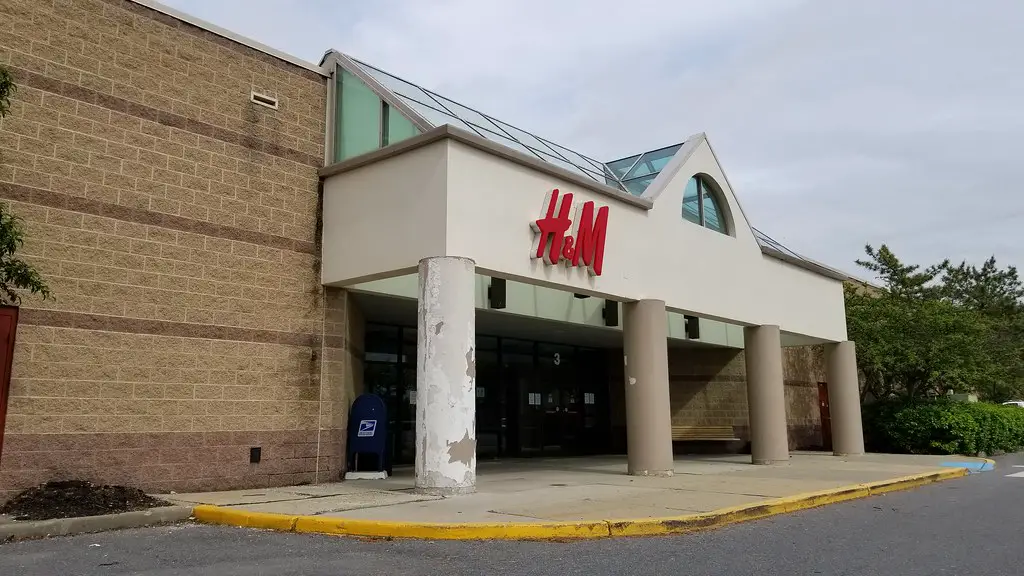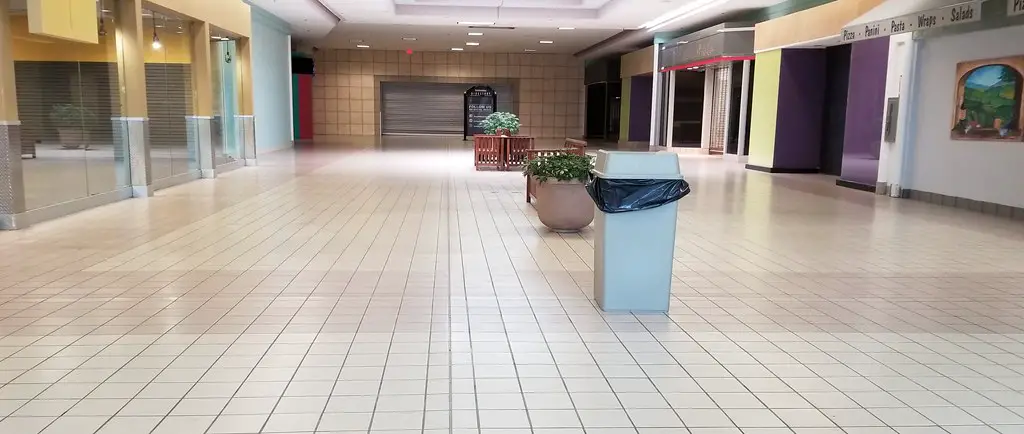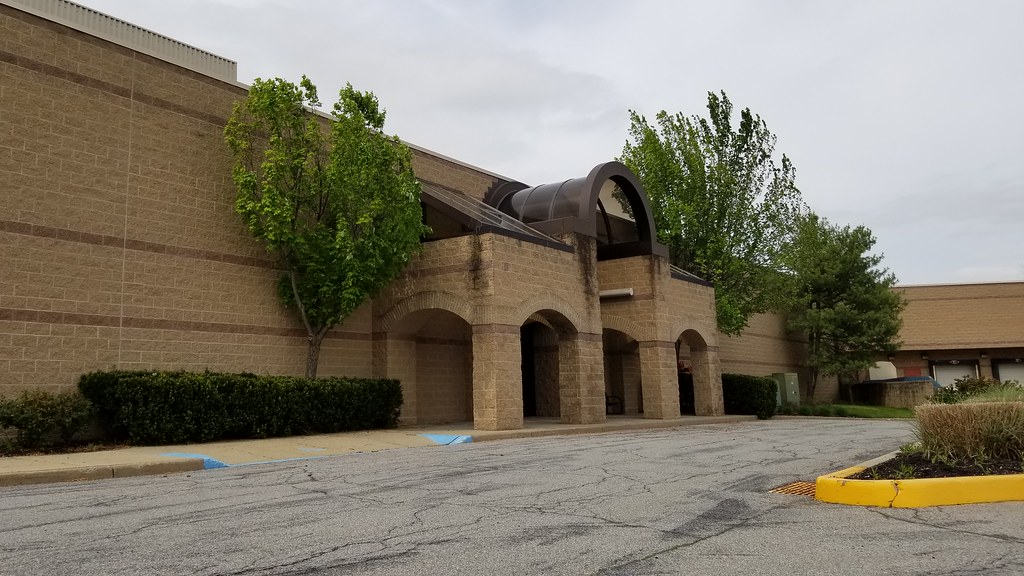The Genesis and Early Years of Phillipsburg Mall
Introduction to Phillipsburg Mall
In Warren County, New Jersey, the Phillipsburg Mall opened its doors on September 24, 1989. This shopping center, strategically located along U.S. Route 22, was not just a commercial hub but a significant addition to the region’s retail landscape.
Developed by Crown American, the mall initially boasted a total retail floor area of 579,000 square feet, accommodating a variety of stores and services.
Its anchor stores were a testament to the era’s retail giants: Kmart, Hess’s (marking its first and only location in New Jersey), and Sears, drawing shoppers from across the region.
Early Success and Expansion
The mall’s grand opening was a landmark event, attracting over 7,000 people. This overwhelming response indicates the mall’s potential as a retail powerhouse.
The excitement was palpable, with traffic on U.S. Route 22 experiencing backups for miles. In March 1990, JCPenney joined the mall, further solidifying its status as a premier shopping destination.
The addition of JCPenney not only expanded the mall’s retail offerings but also enhanced its appeal to a broader demographic.
Changes in Anchor Stores
The retail landscape is ever-evolving, and Phillipsburg Mall is no exception. 1994, a significant change occurred when the Hess’s store was sold to The Bon-Ton, marking a new chapter in the mall’s history.
However, the turn of the millennium brought challenges; Kmart closed its doors in 2002 amidst bankruptcy proceedings.
This closure marked a shift in the mall’s dynamics, but it was soon followed by a new beginning when Kohl’s took over the space in 2004.
This change was part of the broader retail industry’s shifts, reflecting changing consumer preferences and economic conditions.
As the Phillipsburg Mall navigated these changes, it remained a key player in the area’s retail scene.
For those looking for things to do in Phillipsburg, New Jersey, the mall offered various shopping and leisure options, making it a destination for locals and visitors.
The early years of Phillipsburg Mall set the stage for its journey as a central commercial and social hub in the region.
Ownership Changes and Challenges
Ownership Transitions
The Phillipsburg Mall, a cornerstone of retail in Warren County, experienced significant changes in ownership over the years.
In 2003, Pennsylvania Real Estate Investment Trust (PREIT) acquired the Crown American portfolio, which included the Phillipsburg Mall.
This acquisition was part of a larger trend in the retail real estate market, where consolidation became a common strategy for managing large-scale properties. However, in 2013, the mall witnessed another major shift.
Mason Asset Management and Namdar Realty Group, known for their investments in retail spaces, purchased the mall for $11.5 million.
This change in ownership reflected the evolving nature of retail real estate investments and the challenges traditional shopping malls face.

Decline in Tenancy
The period following the change in ownership was marked by a gradual decline in the mall’s tenancy.
In January 2014, a significant blow came with the announcement of the JCPenney store closure, part of a nationwide plan to shut down 33 locations.
This closure was a symptom of the broader challenges faced by department stores in the digital age.
The departure of JCPenney, a key anchor tenant, had a ripple effect, leading to an exodus of other stores.
Between 2013 and 2014, the mall saw a noticeable decrease in occupancy, with many smaller stores leaving, signaling a downturn in the mall’s commercial viability.
Efforts to Revitalize
In the face of these challenges, efforts were made to revitalize Phillipsburg Mall. New shops began to open, attempting to fill the void left by traditional retailers.
In 2017, Black Rose Antiques & Collectibles took over the former JCPenney space, offering a unique shopping experience.
Additionally, Spin Me Round Records, a record store, opened near the former JCPenney space, bringing a niche market to the mall.
These new additions were part of a strategy to diversify the mall’s offerings and attract different customer segments.
Despite these efforts, the mall’s struggle needs help with the changing retail landscape, marked by the rise of e-commerce and consumer preferences.
The Decline of Phillipsburg Mall
Store Closures and Impact
The decline of Phillipsburg Mall became increasingly evident with the closure of several key stores. In 2018, Sears, one of the mall’s original anchor tenants, announced it would be closing as part of a larger plan to shut down 63 Sears and Kmart stores nationwide.
Effective January 28, 2018, this closure significantly hit the mall’s foot traffic and commercial appeal.
The same year, another anchor, The Bon-Ton, faced its demise amidst financial struggles, with the Phillipsburg location confirming its closure in April 2018.
These closures indicated the broader challenges traditional brick-and-mortar stores face in an era increasingly dominated by online shopping.

Structural Issues
The mall’s physical infrastructure also began to show signs of distress. In August 2018, a severe rainstorm led to the collapse of a portion of the roof in the former Sears section, approximately 200 square feet in size.
This incident raised safety concerns and further diminished the mall’s attractiveness to shoppers and retailers.
As a result, several stores on the Sears side of the mall relocated closer to the Kohl’s side, while the Sears area remained blocked off.
This physical deterioration was symbolic of the mall’s overall decline.
Final Years and Closure
A steady decrease in tenancy and customer visits marked the final years of Phillipsburg Mall.
In November 2017, the mall’s ownership, Mason Asset Management, hinted at the property’s uncertain future, suggesting it might be better suited for purposes other than a mall.
The culmination of declining sales, store closures, and structural issues led to the inevitable.
On December 23, 2019, the remaining tenants received lease termination notices, giving them 30 days to vacate. This marked the beginning of the end for Phillipsburg Mall.
By March 2020, the mall had effectively ceased operations, with Kohl’s owning a separate parcel, stating it would remain open.
The closure of Phillipsburg Mall reflected a trend seen across the United States, where traditional malls struggled to compete with the convenience and variety offered by online shopping platforms.
Demolition and Redevelopment Plans
Demolition Announcement
The final chapter of Phillipsburg Mall began with the announcement of its demolition. In January 2021, Mason Asset Management, the mall’s owner, revealed plans to dismantle the once-bustling shopping center.
This decision came after years of declining foot traffic, store closures, and structural challenges. The demolition, scheduled to begin in the following weeks, was set to be completed by June 2021.
This marked a significant moment in the history of Phillipsburg, as the mall had been a central part of the community’s commercial landscape for over three decades.
Redevelopment Plans
The space formerly occupied by Phillipsburg Mall was earmarked for a new purpose. The proposed redevelopment plan included the construction of a large-scale warehouse encompassing an area of 852,000 square feet.
This shift from retail to industrial use reflected broader economic trends and the growing demand for logistics and distribution centers, driven partly by the surge in e-commerce.
The redevelopment plan was about replacing the mall and adapting to the changing economic landscape and the needs of the modern marketplace.
Community Response
The announcement of the mall’s demolition and subsequent redevelopment plans elicited mixed reactions from the Phillipsburg community.
For many, the mall was more than just a shopping center; it was a place of memories, social interactions, and a symbol of the town’s economic vitality.
While economically practical, the shift towards industrial use significantly changed the community’s character and landscape.
Residents and former shoppers reflected on the mall’s past, its role in their lives, and the implications of its transformation, highlighting the evolving nature of urban spaces and commercial development.
Warehouse Plan for Former Phillipsburg Mall Site Moves Step Forward in 2023
As developers, J. Petrucci and CRG Integrated Real Estate Solutions have proposed building two distinct warehouse facilities called “The Cubes.”
These facilities are planned for the location of the old mall and the area directly surrounding it.
One of these warehouses is set to cover the area of the former Phillipsburg Mall itself, spanning nearly 850,000 square feet.
The second warehouse, planned to be located behind the mall area, will cover around 570,000 square feet.
This development indicates the changing landscape of commercial real estate, where retail spaces give way to industrial and logistics facilities.
This development is part of a broader initiative to add 11 properties to the current Highlands Center area, which covers the most intensely developed portions of the townships.
The concept behind the Highlands Centers is to foster equitable development across the region.
This approach aims to sustainably encourage economic progress while safeguarding essential environmental and historical resources.
The redevelopment plan for this site also includes provisions for the construction of affordable housing, potentially resulting in up to 96 residential units.
This aspect of the project reflects a growing trend in urban planning, where mixed-use developments are increasingly favored to create more integrated and sustainable communities.
However, this plan was subject to controversy. Residents and local community members expressed concerns about the potential impact of such a development.
The fears ranged from increased traffic and environmental issues to losing a community-centric space.
The reaction from the local population was one of mixed feelings. On one hand, the development promised economic benefits, such as job creation and increased commercial activity.
On the other hand, there was a strong desire to retain the community aspect of the mall.
Suggestions for alternative uses of the space included recreational facilities, green spaces, or smaller-scale commercial establishments that could serve the local community’s needs more directly.

Conclusion
Reflecting on Phillipsburg Mall’s Journey
The story of Phillipsburg Mall, from its grand opening in 1989 to its closure in 2020 is a narrative that mirrors the broader trends in the retail industry.
Once a bustling hub of commerce and social interaction in Phillipsburg, New Jersey, this mall experienced the highs of retail success and the lows of economic downturns.
Its evolution reflects the changing dynamics of shopping habits, the challenges faced by traditional brick-and-mortar stores, and the impact of e-commerce on physical retail spaces.
The Mall’s Role in the Community
Phillipsburg Mall was more than just a shopping center; it was a part of the community’s fabric. It served as a place where people shopped, socialized, and created memories.
The mall’s closure marked the end of an era for Phillipsburg, symbolizing the shift in retail trends and consumer preferences.
The nostalgia and memories associated with the mall underscore its significance in the lives of those who frequented it.
Looking Towards the Future
The transformation of the Phillipsburg Mall site into a warehouse and the shift in the retail landscape of Phillipsburg signify the adaptability and resilience of the community in the face of change.
The future of retail in Phillipsburg is likely to be shaped by innovation, diversification, and a blend of traditional and modern shopping experiences.
As the town adapts to these changes, the legacy of Phillipsburg Mall remains a testament to the evolving nature of retail spaces and their role in shaping community dynamics.


Pburg is poor and will never have anything nice to go like an upscale mall. The local government only sees dollar signs in wanting more warehouses.
Thank you for sharing your comment about Phillipsburg. While it’s understandable to have concerns and desires for the community, I believe that positive change is always possible. Local governments face various challenges and considerations when it comes to economic development.
In response to a prior comment that “Pburg is poor,” I can testify that while employed at a jewelry store for ten years at the Philliosburg Mall, it was common to have to request upscaled- priced jewelry for local shoppers. It is sad to be labeled a depressed area. Locals are now forced to travel or shop online.
Thank you for shedding light on the true spirit of Phillipsburg. It’s clear that despite economic labels, locals have a taste for finer things and the capacity to support local businesses.
In the town of Phillipsburg, yes there are mostly middle class and poor people. But when you get to the outskirts of town, the edges of the town and more to the surrounding countryside, that is where you will find the more affluent middle class to wealthier people.
I have lived in the Easton/Phillipsburg area my whole life. It has drastically changed! Areas that were once farm land or woods are now housing developments or warehouses or retail strip malls or a mix of them. A lot of places that were once vibrant are now closed and gone forever! Like the old Dixie cup plant in Wilson, PA that closed and moved up to Forks Township, but now that is closed. The old Maiers bakery in Wilson, PA. that was bought out by another company kept open for a short time then closed. The property was then sold and the bakery was demolished and the site is now medical offices.
Some things that hurt the Phillipsburg mall were other newer malls opening. Some were smaller strip mall complexes, and some were regular malls. Add to that the e-commerce boom, plus the prices the stores had to charge customers for their products/services, it became uncompetitive.
Sorry for the long post.
Thank you for sharing your perspective. Your detailed story of the Easton/Phillipsburg area transformation is enlightening. It’s evident how these changes have impacted local landmarks like the Phillipsburg Mall.
The Phillipsburg Mall was a huge part of me growing up. The all day shopping trips with family eating in the food court or just hangout shopping with friends. The Mall as we called it when we were younger was the go to place. Walking from town all the way to The Mall was a super popular thing to do for the teens. I’m sad it’s gone so many amazing memories prom dress shopping graduation shopping wedding dress shopping was all done there.
Your memories of the Phillipsburg Mall resonate deeply. It was indeed a central part of the community, where many milestones were celebrated. It’s sad to see such places go.
it was a nice place and now it’s gone and we don’t need no more warehouses it’s getting to be a
problem in the city